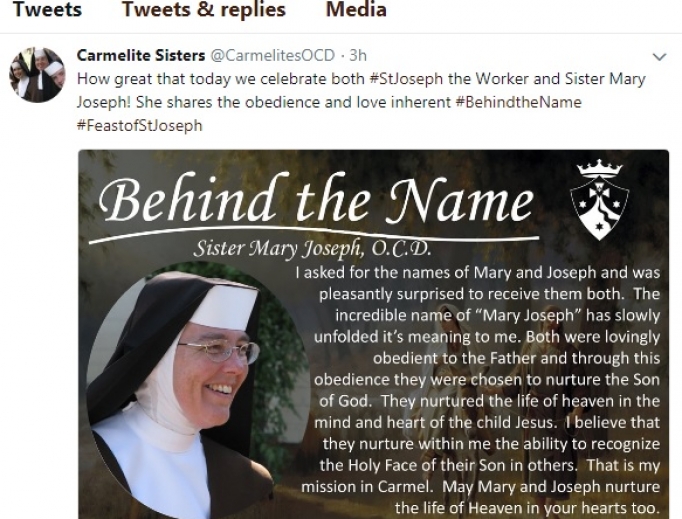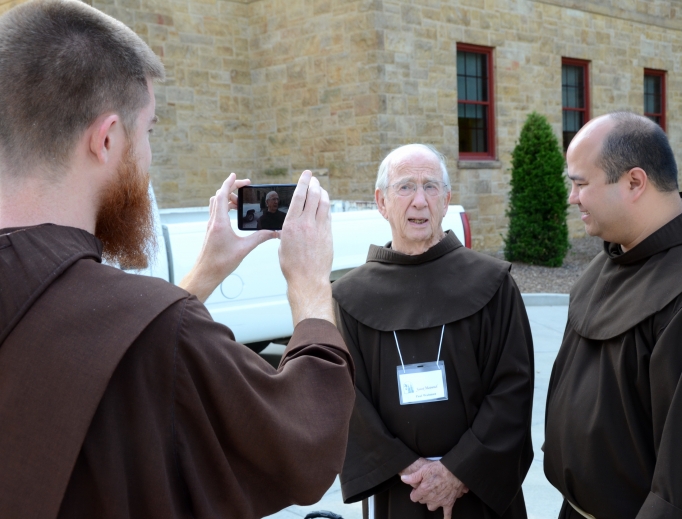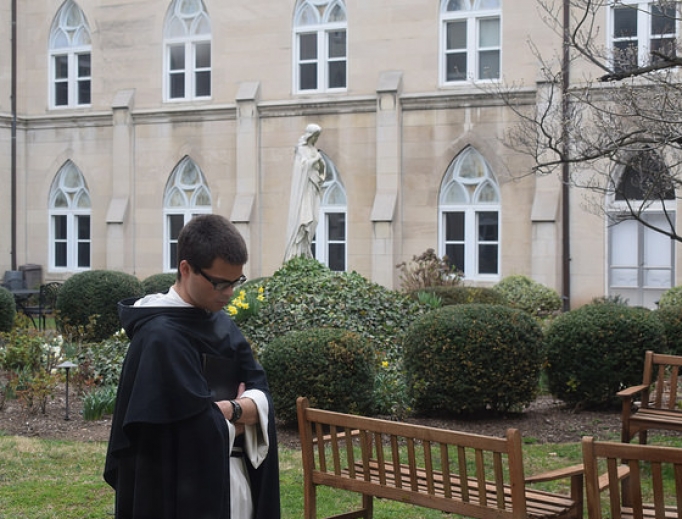Religious Orders Use Social Media to Draw Millennials to Vocations
Innovative ways of communicating are paying dividends in helping young Americans to discern religious life.

It seems there is nothing the Sisters of Mercy don’t do. And now, in recent years, the Sisters of Mercy in the Americas have come to be known for one more thing: their aggressive use of social media.
Members of the order, which is dedicated toward carrying out the seven corporal and seven spiritual works of mercy, work as teachers, housing caseworkers and counselors. They run orphanages, retreat centers and hospitals. One affiliated home in the Philippines holds catechesis classes for women who also work by making herbal syrups, soaps and candles. One ministry in Sacramento, California, reaches out to the homeless by bicycling through the city streets to minister to them.
Sister of Mercy Cynthia Serjak, the head of the institute’s membership office, tweets at a pace of about several Twitter messages per week — on everything from Earth Day-related messages to reflections on the power of forgiveness during Lent. She is one of the institute’s four “Social Sisters” — a team that has fanned out across social media to share anecdotes, insights and spiritual lessons.
In addition to their individual use of social media, the Sisters of Mercy utilize targeted advertisements on Facebook and Google, according to Sister Cynthia, a baby boomer who entered the order in 1966. As a result, the order receives numerous online inquiries about its work.
Only a few may actually lead to new vocations. But the connections serve a broader purpose. “It’s an opportunity for people to have a little conversation with us, get to know us better,” Sister Cynthia said. “A lot of millennials don’t know sisters these days.”
It’s not just the Sisters of Mercy. Having a presence on social media has become indispensable to a number of men’s and women’s religious communities across the country.
In California, the Carmelite Sisters of the Sacred Heart have active Twitter and Instagram accounts flooded with memes inscribed with prayers and verses and photos and links to stories about the lives of the sisters. One running series, “Behind the Name,” features a photo of a member and a brief history of her name.

Franciscan Initiatives
On the East Coast, Franciscan Brother Casey Cole, who is in his 20s, runs a YouTube channel, “Breaking in the Habit,” where his videos cover such topics as “pro tips” for wearing the habit, the differences among monks, friars and the Jedi, and which of the three vows — poverty, chastity and obedience — he found most difficult. Some of the videos have garnered 40,000 or more views. Brother Casey also runs a blog by the same name and has published a book about his vocation.
In the Midwest, fellow Franciscan Father Richard Goodin started the hashtag #becomeafriar and launched an accompanying dynamic website to help get the order’s message out to potential new members from the millennial generation. His efforts drew the attention of NBC News, which highlighted his digital-media outreach in its online news magazine, Left Field.
For an order whose members dress simply in a brown habit and sandals, taking to the latest tech may seem out of place. But Father Goodin, of the Order of the Friars Minor, says he’s simply following in the footsteps of Franciscans like founder St. Francis of Assisi as well as St. Leonard of Port Maurice and St. Bernardine of Siena, who all used the town squares or marketplaces as a place to preach or gauge the social issues that called out for their preaching.
“We’re not the Benedict Option,” Father Goodin said. “We’re very much run right into the marketplace, and we’ve been that way since the beginning.” So far, about half of the people who have expressed an interest in his province of the Franciscans, St. John the Baptist, which is based in Cincinnati, Ohio, say they found out about it through his website.

Encouraging Stats
If figures for new entrants into religious orders are any measure, the social-media efforts of religious orders are succeeding.
The Register’s own review of recent surveys on membership in religious orders produced by the Center for Applied Research in the Apostolate (CARA) at Georgetown University shows a potential uptick in the number of new entrants for men’s and women’s religious orders.
In 2015, there were 411 men and women who entered religious orders, based on responses to a CARA survey. Last year, that number went up to 524. That data only goes back for the past three years. But for about a decade CARA has also been issuing reports on how many men and women have remained in the orders they entered to the point of professing final vows. Those figures also show a potential rise.
In 2017, 208 men and women professed final vows; in 2011, the total was 122. There hasn’t been a steady rise in the intervening years — in 2013, for example, the number dipped to 107 — but, overall, the arrow appears to be headed upward in a potential trend that bucks the long-running narrative that religious orders are dying out.
“I’m not willing to call it a trend yet, but I will say that it is encouraging to see that several hundred men and women profess perpetual vows in religious life in the United States each year. This is a sign of hope for all Catholics,” said Mary Gautier, a senior research associate at CARA.
In 2017, the average age of those entering orders was 28, firmly in the middle of the millennial generation, defined by the Pew Research Center as anyone who was born between 1981 and 1996.
VocationMatch.com
In their effort to reach millennials, religious orders and the organizations helping them are leaving no tool unused. That even includes a version of something like a CatholicMatch.com for people who are discerning a vocation to religious life and seeking guidance on which order might be the best “match” for them.
The site, VocationMatch.com, launched in 2007 and is run by the VISION Vocation Network, a publication of the National Religious Vocation Conference.
The match page guides users through 38 questions on everything from basic demographic information to how often they would want to pray with members of their community to the importance of wearing a habit.
At the end of the survey, the religious orders that seem like a potential fit are listed in order of how closely they match the person’s background and spiritual disposition.
Since 2007, about 55,000 men and women have taken the Vocation Match quiz. A 2012 survey revealed that about a third “had entered or were entering religious life,” while another third were “still weighing their options,” according to information provided by Patrice Tuohy, the publisher of the VISION Vocation Guide for the National Religious Vocation Conference.
In addition to its interactive website, the vocation network has an active presence on Facebook, Twitter, Instagram and YouTube. And it is exploring ways to keep up with the latest trends in media technology.
For example, Tuohy said the network is looking into creating a skills program that would allow “virtual assistants” like Alexa or Siri to answer questions about religious life.
“I doubt that Alexa or Siri would understand what to do with the questions: How do I become a priest? Or what religious community is right for me? So we want to help ‘train’ these devices on potential places to recommend the questioner go to find the answers,” Tuohy said.
‘Friend Me on Facebook’
Social media doesn’t just help millennials learn more about religious orders; it also helps those orders get to know their potential new members.
One order that has seen major upsurge in vocations is the Dominican Province of St. Joseph. Over the last eight years, the province has received more than 75 men into the order and ordained 48 men to the priesthood. Dominican Father Benedict Croell, the head of vocations for the province, said social media has been an important part of the recruitment process.
“The first thing I tell guys, ‘Friend me on Facebook,’” Father Croell said.
Given the large size of the province, Father Croell said Facebook also helps him simply keep in touch with men who are interested in the Dominicans. It also is a means of pre-screening prospective members of the order.
“It gives me some idea of who a man is,” he said.
Social media has helped out in unexpected ways, as well.
At one point, the vocation weekends held four times a year at the Dominican House of Studies in Washington, D.C., had become so crowded that Father Croell took to Facebook to ask for help. Within one day, he said supporters of the Dominicans had purchased 21 cots for the order.
“It helps us on two levels — to reach millennials, but also to reach benefactors; to reach people who actually care and who love the Dominicans, basically,” Father Croell said.
Social media is but one factor in many that explain the great success the Dominican Province of St. Joseph has had with vocations. But, ultimately, Father Croell says there is only so much that can be done by the order itself.

“It’s a miracle from God, really,” Father Croell said. “I don’t know how else to describe it.”
Register correspondent Stephen Beale writes from Providence, Rhode Island.
















